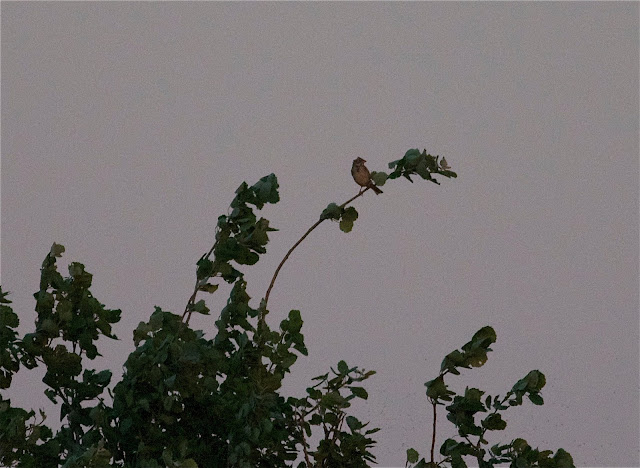After waking at 5am & leading 2 overwarm classes at an urban site during the day, I wondered what I was doing leading another session for 3 hours in the evening. The omens didn’t augur well with very gusty conditions and the news that like many other migrants this year Nightjars are arriving late. Luckily, Chris Cox offered to pick me up as he was driving past, so there was no chance of me dropping off at the wheel on the return journey.
The Moon with Vapour Trail
Grey Partridge (c) 2012 Chris Cox
We arrived at the destination at about 7.15 pm and were surprised to discover that almost every participant was already present. As Chris turned in to the lane towards the parking area we saw a Grey Partridge, a Yellow Wagtail and Skylarks – we had already seen a very bright male Yellowhammer by the road just a mile before the turning. Meanwhile from the parking area the attendees had spotted Sand Martins, Oystercatcher and a Plover, which required fine-tuning for ID purposes. It was too far away from here, but from the hide it had a gold ring round the eye, so it was a Little Ringed Plover. The most confiding bird was a miserable Coot! Also on the large lake were Lapwings, Mute Swans, a Great Crested Grebe, a Little Grebe, Pied Wagtail, Tufted Ducks and the dreaded Canada Geese. I thought I could hear a distant Corn Bunting, but I couldn’t pin it down at this stage.
A Scumbag
Record shot of Green Woodpecker
On the walk to the next hide Sue M spotted a Green Woodpecker landing on a Silver Birch, so most people were able to see it before it was frightened off by a Magpie. We also saw a Woodlark fly up from the ground, while Linnets flew overhead. Meanwhile, Chris continued with his specialist subject when he saw 2 Herons flying distantly over the fishing ponds. Reed Buntings and Reed Warblers could be heard singing from the reedbeds, we tracked down the former, but the latter remained concealed in dense cover. From the hide we heard a Cuckoo and David managed to lock onto the Corn Bunting singing on a distant bush – all we could observe from the hide was a plump blob, throwing its head back to sing.
Great Spotted Woodpecker (c) 2012 Richard Whateley
Crepuscular Record Shot of Yellow Wagtail
Crepuscular Record Shot of Great Crested Crebe
(c) 2012 Richard Whateley
We didn’t see a great deal between the hides and the next one, so we made our way back to the car park and then walked along a country lane swarming with insects. David spotted a Yellow Wagtail, whilst 3 Gadwalls flew over, as did a single Great Crested Grebe – a sight many of the ‘students’ hadn’t previously observed. There was a beautiful, peaceful sunset, and even as the light faded a Kestrel continued to hover, whilst the Cuckoo became much more vocal. We crept towards the Corn Bunting, so everyone obtained a better view, and on the way we saw a pair of Grey Partridges and a Hare munching in a field of young maize.
Crepuscular Record Shot of Corn Bunting
(c) 2012 Richard Whateley
Crepuscular Record Shot of Grey Partridge (c) Richard Whateley
Crepuscular Flies
In the end it was too dark for a Nightjar Photo, but this is a
View of a Nightjar we'd all have Preferred to the One we Got!
(c) 2012 Mick & Kath Sharpe
We headed back to the cars as the light began to fade. In the crepuscular world of half-light we listened to a Cuckoo and a Song Thrush, whilst a few duck species whizzed over our heads, and Swans lumbered towards the ponds for the evening. The arrival of a phalanx of trumpeting Canada Geese narrowly missing the tree tops as they headed for the lake, seemed almost magical as the darkness began to take complete control. It was at this moment (10.15pm) that a fluttering was noticed among the trees just above our heads – at last a Nightjar. She returned another couple of times before suddenly disappearing without any clue as to her direction of departure. There were no churring noises heard, or any of the usual clicking flight notes, or wing-clapping, and as far as I could make out there weren’t any white wing-patches, so I suspect our bird was a female. The white hankies which I duly trotted out were completely ineffectual, which is another reason I suspect we were dealing with a female bird – a male is supposed to aggressively investigate any white patches moving in its territory. We waited for another quarter of an hour, but she failed to return.
Luckily, the Nightjar Special delivered the goods, but I think next time I try & look for Nightjars, I’ll ensure I've had a full night's sleep the previous evening....












No comments:
Post a Comment